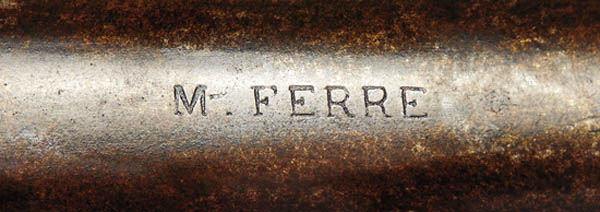Rare Revolutionary War Pistol Acquired By Historic Rock Ford
Early Firearm Currently On Display
September 15, 2023
Historic Rock Ford in Lancaster, Pa., is pleased to announce an exciting acquisition, an American Revolutionary War flint lock pistol made by gunsmith Manuel Ferree, now on display in the John J. Snyder, Jr. Gallery of Early Lancaster County Decorative Arts. The pistol is engraved in block letters M. Ferre on both the lock and the barrel. In addition, it has a large, engraved letter P proof mark on rear of the barrel. In 1776, Congress directed the various Committees of Safety in the 13 colonies to manufacture 3,000 dragoon pistols. These were to be patterned after the British Light Dragoon pistol that was developed for Britains horse-mounted infantry in the 1760s. The barrel length of the original British pistols was initially 16 inches, but by the time of the American Revolution, the barrel length had been shortened to 9 inches by both the British and the Americans. These pistols were carried in pairs in leather holsters slung over the horses withers in front of the saddle of the mounted troop. The actual number of pistols that were manufactured by the various Committees of Safety is uncertain. Most Committee of Safety gunsmiths were involved in making long arms, primarily flint lock muskets, and few records survive. Consequently, these pistols are widely considered rare; around 17 are thought to exist. Six of the surviving signed examples were made at Rappahannock Forge in Falmouth, Va. One is signed by Connecticut gunsmith Matthew Sadd. Five of them are known, that although unsigned by the gunsmith, are martially marked or stamped U.S. on the stocks or lock plate. This newly acquired pistol signed M. Ferre was made by Lancaster gunsmith Manuel Ferree. It is currently the only known Revolutionary War Light Dragoon pistol that is signed by a Pennsylvania gunsmith. The museum was able to purchase this pistol with a partial gift from historian John Kolar. Emmanuel (Manuel) Ferree was born in 1753, the son of Jacob Ferree and Barbara Carpenter. He shows up in the local tax records of Lancaster County in 1776 along with Joel, Jacob, and Isaac. Surviving records show that he worked for the Committee of Safety at various times between 1776 and 1783. During the American Revolution, he also served for a short time as a lieutenant in the Fourth Company of the 9th Battalion of the State Militia. After the conflict, he married Mary Gibboney and is listed in the first national census in 1790 as a resident of Strasburg, Leacock Township. In 1795, Manuel and Mary purchased a 400-acre farm in Jefferson County, Ky. Early in 1803, they signed an indenture to support the purchase of this land. Manuel Ferree died in 1803 at the age of 50. The .70 caliber barrel is 9 1/16 inches long, with PA proof, original flint lock, stocked in American walnut, with an overall length of 15.75 inches. About Historic Rock Ford During the American Revolution, Edward Hand (1744-1802) was adjutant general to George Washington. His home is located at Historic Rock Ford, comprised of 33 acres at the southeastern edge of Lancaster City, surrounded by Lancaster County Central Park. It offers guided tours of the elegantly furnished rooms of the ca. 1794 Hand Mansion as well as the opportunity to visit the John J. Snyder Jr. Gallery of Early Lancaster County Decorative Arts, which is housed in a re-constructed 18th-century bank barn. Visitors to the Snyder Gallery will also have the opportunity to see other rare and historic firearms that are currently on display for a limited time, including long rifles made by Lancaster craftsmen Andreas Albrecht, Peter Resor and Jacob Metzger. Also on display is a pistol made by J.P. Beck, currently on loan from the Historical Society of Dauphin County. To learn more, visit www.historicrockford.org or call 717-392-7223 for information regarding seasonal hours, tour times, special events and admission prices.



SHARE
PRINT